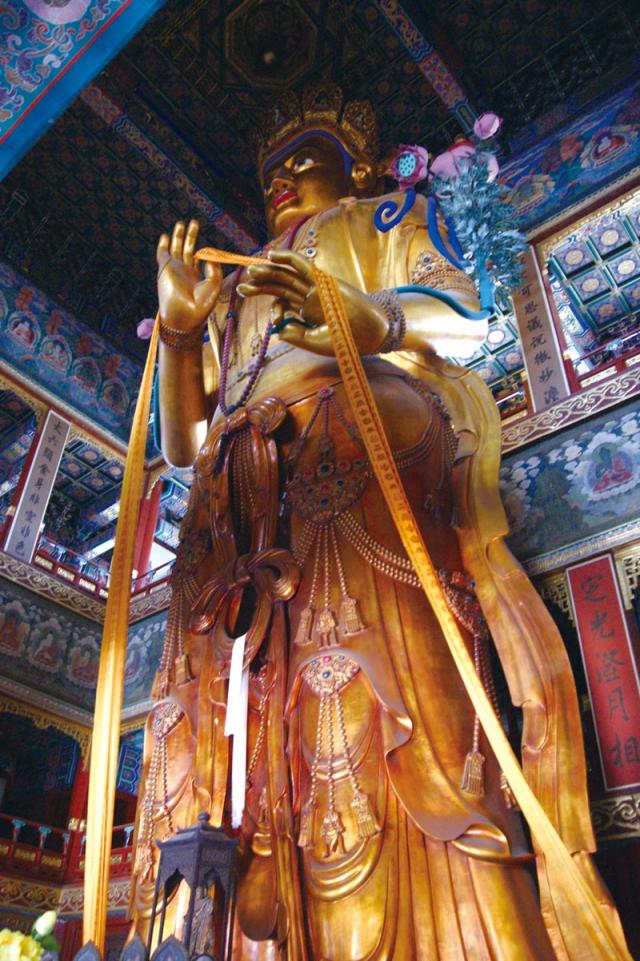My foremost memories are dominated by the roar of busy roads, dodging the mopeds that appeared from a thick yellowish haze, and bumping into people bustling through the streets. While such scenes still prevail in much of the city, my most recent visit showed me a very different side to the capital.
After almost 24 hours of travel and very little sleep, we landed in Beijing one sunny June morning, the bright blue of the sky only vaguely dusted with a thin veil of haze, and wound our way by taxi through the city and into the narrow, gray-walled alleyways of Beijing, known as hutong. Our guesthouse was hidden behind two towering doors, shutting out the bustle of the outside world as they thudded closed. The blue-painted courtyard was adorned with plants, and to one side we found a cozy tea room filled with musical instruments of all descriptions. I could not have hoped for a more pleasant start to our trip.
Throwing our rucksacks onto the traditional kang (brick) bed, we headed toward the Summer Palace, where we spent a blissful afternoon wandering through the gardens. The world-renowned beauty of the palace was one of the reasons it was the favorite imperial dwelling place during the Qing Dynasty. At least, it was until 1860 when it was destroyed by Anglo-French troops retaliating against the torture and execution of their envoys at the hands of the emperor. Details of this event are signposted at frequent intervals throughout the palace and gardens, conveniently translated for any passing Anglo-French tourists to ponder.
Although tourists and inescapable tacky gift shops abound around the palace itself, the waters of Kunming Lake offset the impact of the crowds. As we strolled along the water’s edge, a warm wind carrying the threat of a storm blew the heat from our faces, setting the willow trees lining the bank dancing. Ripples spread across the waters, lifting the lily pads which now bobbed upon the growing waves. We lost ourselves in the beautiful gardens, covering a substantial part of the lake’s circumference before hitching a ride on the last dragon boat of the day which ferried us across the water. We finished our stroll beside a beautiful pagoda in time to see the golden sun set behind the blue mountains, strewing the gardens with shadows while its ornate towers stood silhouetted on the horizon. The palace is only enhanced by the evening light which, coupled with the lighter tourist numbers, make it the best time to take in this beauty spot.
After a restful night’s sleep, we dedicated the second day to visiting the Lama and Confucius temples. Once a place of silence and worship, the former, also known as the Yonghe Lamasery, is now a tourist hotspot, and although we visited at lunchtime, the crowds were still substantial. It is incredibly beautiful, combining Han Chinese and Tibetan styles in its art and design, and I would definitely add it to the list of top places to visit in the capital. One of the main attractions is a world record-breaking 26-meter-tall Buddha, carved from a single piece of white sandalwood. After thoroughly exploring the lamasery’s seemingly never-ending series of ornately decorated halls, we found our way down a long leafy avenue nearby, and refreshed ourselves in one of the little cafes supplying local delicacies, and vital caffeine for people adapting to new time zones.
Our strength and zen restored, we headed to the Confucius Temple shortly before closing time (last tickets sold at 5:30pm). Built in 1302, it harbours the spirit of ancient scholarly endeavour, with traditional ceremonies still taking place in the great Da Cheng Hall (Hall of Great Achievement), while within its expansive courtyards one can find stone tablets onto which thousands of wisdom-conveying characters have been painstakingly carved. Favorite curiosities among visitors include the ancient tree known as the Chujian Bai, or “touch evil cypress,” so-called for allegedly knocking the hat off a treacherous official who visited the temple during the Ming Dynasty, leading people to speculate that it could distinguish between good and evil. While the offending branches are now seemingly restrained, we nevertheless gave it a wide berth.
By the time we visited, the tour groups had long moved on, leaving us free to wander the grounds undisturbed. The silence in the temple was matched by the calm in the gardens as the evening light flickered on the green waters of the moat surrounding the central pagoda, crossed by a series of ornate marble bridges. In fact, so peaceful did we find the empty courtyards that we sat down on a bench, and fell asleep briefly only to find on waking that the grounds had closed. We had to interrupt the evening debrief of the guards to be let out once again into the bustling streets beyond the temple wall.
That evening we wound our way through a maze of alleyways too narrow for cars, toward a second hutong guesthouse where we were to stay the night. In the dim light of dusk not a soul was around, although warm glowing lights and the faint sound of laughter spilled from under the ornate wooden doorways as we passed. Our guesthouse had a wonderful, leafy rooftop terrace, where we sat eating fresh mangosteen in the twilight, a warm wind blowing through the trees, concealing any city noises that would betray the fact that we were in one of the most densely populated places in the world.
As we left the next day, standing amid the hubbub of the railway station, I wondered at the enchanting stillness I had encountered, right at the heart of Beijing.

 Old Version
Old Version
